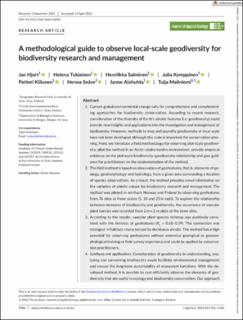| dc.description.abstract | Current global environmental change calls for comprehensive and complementing approaches for biodiversity conservation. According to recent research, consideration of the diversity of Earth's abiotic features (i.e. geodiversity) could provide new insights and applications into the investigation and management of biodiversity. However, methods to map and quantify geodiversity at local scale have not been developed although this scale is important for conservation planning. Here, we introduce a field methodology for observing plot-scale geodiversity, pilot the method in an Arctic–alpine tundra environment, provide empirical evidence on the plot-scale biodiversity–geodiversity relationship and give guidance for practitioners on the implementation of the method.
The field method is based on observation of geofeatures, that is, elements of geology, geomorphology and hydrology, from a given area surrounding a location of species observations. As a result, the method provides novel information on the variation of abiotic nature for biodiversity research and management. The method was piloted in northern Norway and Finland by observing geofeatures from 76 sites at three scales (5, 10 and 25 m radii). To explore the relationship between measures of biodiversity and geodiversity, the occurrence of vascular plant species was recorded from 2 m × 2 m plots at the same sites.
According to the results, vascular plant species richness was positively correlated with the richness of geofeatures (Rs = 0.18–0.59). The connection was strongest in habitats characterized by deciduous shrubs. The method has a high potential for observing geofeatures without extensive geological or geomorphological training or field survey experience and could be applied by conservation practitioners.
Synthesis and applications. Consideration of geodiversity in understanding, analysing and conserving biodiversity could facilitate environmental management and ensure the long-term sustainability of ecosystem functions. With the developed method, it is possible to cost-efficiently observe the elements of geodiversity that are useful in ecology and biodiversity conservation. Our approach can be adapted in different ecosystems and biodiversity investigations. The method can be adjusted depending on the abiotic conditions, expertise of the observer(s) and the equipment available. | en_US |

